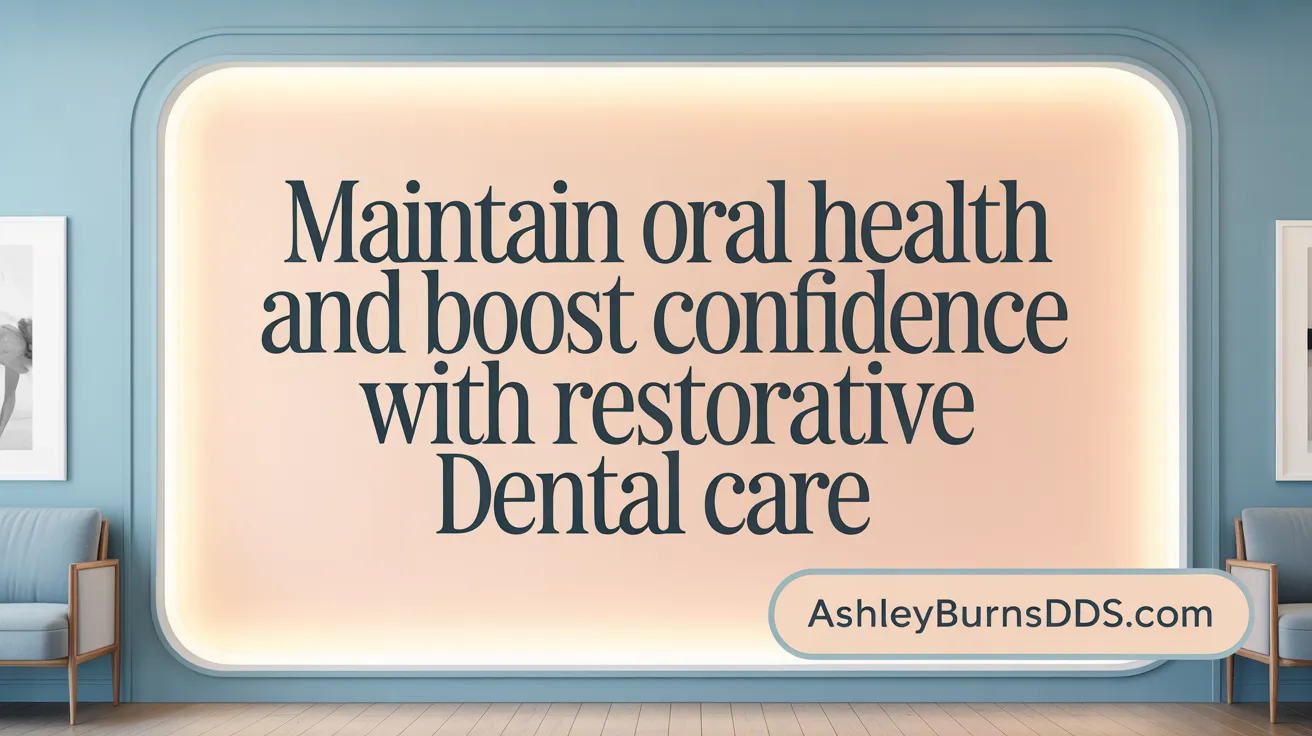Introduction to Restorative Dental Visits
Restorative dental visits are essential for repairing and replacing damaged or missing teeth, restoring oral health, function, and aesthetics. For many patients, these appointments may seem daunting due to the complexity of procedures and the involvement of multiple stages. This article will guide you through what to expect during a restorative dental visit, discussing common procedures, preparation tips, patient comfort strategies, and post-treatment care. Understanding the process helps alleviate anxiety and empowers patients to achieve the best possible outcomes.
The Importance and Benefits of Restorative Dentistry

Why restorative dentistry is essential
Restorative dentistry is fundamental in maintaining and restoring oral health after damage or decay. It helps repair broken, chipped, or decayed teeth, ensuring they function properly for chewing and speaking. Without these treatments, damaged teeth may worsen, leading to infections, pain, and further tooth loss. For more details, see Restorative dentistry overview.
Health and functional benefits
By restoring damaged or missing teeth, restorative procedures like crowns, fillings, and implants protect against infection, prevent further decay, and stabilize your bite. They support better jaw alignment and reduce discomfort, enabling normal eating and speaking. Learn about the Dental restoration benefits.
Aesthetic and quality of life improvements
Restorative dental work enhances your smile, boosting confidence and social interactions. Restored teeth look natural and help you maintain an attractive appearance. Improved oral function also contributes to a higher quality of life, making everyday activities more comfortable and enjoyable. Read more on Improving Smile Appearance with Restorative Dentistry.
Prevention of further dental issues
Timely restorative treatment prevents minor dental problems from escalating into serious issues. For example, filling a cavity stops decay from spreading and avoids the need for more invasive procedures later. Regular dental care combined with restorative treatments helps sustain oral health over the long term. See Preventing future dental problems with Restorative Dentistry.
| Aspect | Benefits | Additional Details |
|---|---|---|
| Function | Restores biting and chewing | Regains proper jaw alignment, prevents misalignment |
| Appearance | Enhances smile and facial aesthetics | Maintains natural look of teeth |
| Comfort | Reduces pain and sensitivity | Alleviates discomfort caused by decay or damage |
| Prevention | Stops further damage | Protects surrounding teeth and jawbone |
| Confidence | Improves self-image | Encourages social and professional interactions |
Knowing how restorative dentistry can improve both health and appearance emphasizes its importance in overall well-being. Regular consultations with a restorative dentist can help identify issues early, ensuring lasting oral health and a confident smile.
What to Expect During the Restorative Dental Visit

Initial examination and diagnostics
A restorative dental visit begins with a comprehensive dental examination process of your teeth, gums, and overall mouth health. The dentist performs a visual inspection and may use diagnostic tools such as dental X-rays for assessment, digital scans, and photographs to identify issues like cavities, cracks, or infections that are not visible to the naked eye. These imaging techniques provide detailed views, aiding in accurate diagnosis and effective treatment planning.
Personalized treatment planning
Based on the examination and diagnostic results, the dentist discusses your specific oral health needs and goals. Together, you explore various treatment options—such as fillings for cavities, crowns for repairing broken teeth, dental bridges to replace missing teeth, root canal therapy process, or implants—and develop a tailored plan. The dentist also explains the procedures involved, expected outcomes, and the estimated timeline, ensuring you understand and agree on the next steps.
Step-by-step procedural overview
During the actual procedure, local anesthesia in dentistry is commonly used to numb the area and prevent discomfort. The dentist begins by removing any decayed or damaged tissue. For restorative options like crowns or bridges, impressions for dental crowns and restorations may be taken for custom fabrication in a dental lab or using CAD/CAM technology for same-day restorations. The restoration—whether filling, crown, or implant—is then carefully fitted and secured. Throughout this process, your comfort is prioritized, and adjustments are made as needed.
Timeline and appointment structure
The duration of the visit depends on the procedure's complexity. Simple treatments like fillings may be completed within 30 to 60 minutes, while more involved procedures like crowns or implants can extend over multiple appointments spanning days or even months. For example, traditional implants may require an initial placement, healing time, and a final attachment, usually over several months. Some advanced technologies, such as same-day crowns, streamline this process into a single visit.
Overall, a restorative dental visit aims to repair or replace damaged teeth, improve function, and enhance the smile. Proper post-treatment care in restorative dentistry and follow-up appointments are essential to maintain the results and ensure optimal oral health.
Common Restorative Procedures Explained
Restorative dentistry offers various procedures aimed at repairing and replacing damaged or missing teeth to restore oral health and function. For a comprehensive Restorative dentistry overview and Benefits of restorative dentistry, you can explore these resources.
Fillings are one of the most common procedures, used to repair small cavities caused by tooth decay. These are typically made from composite resin that matches the natural tooth color, blending seamlessly with the surrounding teeth. Dental fillings help eliminate decay, prevent further damage, and restore the tooth's structure. You can learn more about Fillings for cavities and Types of dental fillings.
Crowns are used for teeth that are severely damaged or weakened. These tooth-shaped caps cover the entire tooth after some enamel is removed, providing strength, protection, and an improved appearance. Dental crowns can be made from materials like porcelain, ceramic, or metal, depending on the tooth location and aesthetic needs. For details on Dental crown procedures and materials, visit these links.
For missing teeth, bridges and dental implants are standard solutions. Bridges consist of artificial teeth supported by crowns placed on adjacent natural teeth or implants. Dental implants involve surgically inserting titanium posts into the jawbone, which act as roots for attaching crowns or bridges. Implants are durable and help preserve jawbone health. Learn more about Dental bridges and Dental implants explained.
Inlays and onlays are custom-made restorations used when cavities are too large for standard fillings but do not require a full crown. They are made of porcelain or composite resin and fit into the natural tooth structure, offering long-lasting support and function. More on Inlays and onlays in restorative dentistry.
Root canal therapy is a procedure performed when decay or cracks reach the tooth pulp, causing infection or pain. It involves removing the infected pulp, disinfecting the canal, and sealing it, often followed by a crown to protect the tooth and restore its function. Details about Root canal treatment process are available.
Additionally, dentures and implant-supported options are used for multiple missing teeth. Dentures are removable prostheses, while implant-supported dentures are anchored onto titanium posts for improved stability. For more info, see Types of dentures and implant-supported dentures.
Understanding these procedures can help patients make informed decisions about their dental health and choose the best options for restoring their smile and oral function. For guidance on consulting a restorative dentist and preparing for restorative dentistry, explore these resources.
Preparing for Your Restorative Dental Appointment
 Before your restorative dental appointment, it’s important to gather comprehensive information about your oral and overall health. This includes bringing a complete list of your current medications, known allergies, previous dental treatments, and any ongoing medical conditions. Sharing this information helps your dentist tailor the restorative dental treatment plan safely and effectively.
Before your restorative dental appointment, it’s important to gather comprehensive information about your oral and overall health. This includes bringing a complete list of your current medications, known allergies, previous dental treatments, and any ongoing medical conditions. Sharing this information helps your dentist tailor the restorative dental treatment plan safely and effectively.
Maintaining good oral hygiene leading up to your visit can also make a positive difference. Brushing and flossing thoroughly help reduce the risk of infection and ensure the dentist can accurately assess your teeth and gums. Additionally, following any specific pre-procedure instructions provided by your dentist, such as fasting or taking certain medications, can facilitate smoother treatment, especially if sedation or anesthesia is involved.
It’s helpful to prepare a list of questions or concerns about the restorative procedure, recovery process, costs, or expected results. Clear communication about your fears, expectations, or symptoms ensures your dentist can address them properly.
Discussing sedation options with your dentist beforehand can help manage anxiety and determine if you need arrangements for transportation post-procedure. Planning ahead for soft foods and recovery time can also ease the process (soft food recommendations).
Organizing transportation, especially if sedation is used, and arriving early for your appointment allow for a stress-free experience. Being well-prepared with all this information enhances comfort, minimizes surprises, and supports successful restorative dental outcomes.
Patient Comfort and Experience During Restorative Treatments

What is the patient experience like during restorative dental treatments and how can anxiety be managed?
Restorative dental procedures are essential for repairing damaged or missing teeth, but they can sometimes cause feelings of nervousness or discomfort, especially in patients with dental anxiety or fear of dental visits.
Many patients experience mild discomfort during treatments, while others might develop significant anxiety, which can impact their cooperation and overall experience. Managing this anxiety involves multiple strategies tailored to individual needs.
Behavioral techniques such as relaxation exercises, deep breathing, guided imagery, and distraction methods like listening to music or watching videos can significantly ease patient worries. Additionally, communication plays a vital role — explaining the procedure clearly, answering questions, and providing reassurance helps build trust and control (importance of patient-centered approach).
Pharmacological assistance, including sedation options like nitrous oxide (laughing gas), oral sedatives, or local anesthesia, is often used for more anxious patients to ensure comfort.
The dental team contributes greatly by creating a welcoming, calming environment. This can include a soothing ambiance with soft lighting, aromatherapy, and ergonomic chair positioning. The use of modern technology, like digital X-rays and less invasive tools, reduces discomfort and shortens procedure times.
Preparation before the appointment, including discussing fears and expectations, helps patients feel more in control. Clear signals, such as raising a hand if they need a break, are commonly established (preparing for dental consultation).
In summary, combining psychological support, environmental comfort, and advanced technology facilitates a positive experience. A patient-centered approach prioritizes understanding individual anxieties and implementing personalized strategies, making restorative treatments less intimidating and more tolerable.
Post-Treatment Care and Recovery Expectations
Managing discomfort and sensitivity
After a restorative dental procedure, it is common to experience some degree of discomfort, including mild pain, sensitivity to hot or cold temperatures, and gum soreness. These symptoms typically diminish within a few days to a couple of weeks. To alleviate discomfort, patients can take over-the-counter pain relievers such as ibuprofen or acetaminophen as recommended by their dentist. Rinsing with warm salt water can also help reduce swelling and promote healing.
Oral hygiene and dietary advice
Maintaining gentle oral hygiene is crucial during recovery. Patients should brush carefully around the treated area, avoiding aggressive scrubbing, and use a soft-bristled toothbrush. Flossing can generally be resumed once the initial numbness wears off, but with care around the new restoration. Dietary restrictions are important in the early healing phase; patients should avoid hard, sticky, or crunchy foods that could dislodge or damage the new restoration. Soft foods like yogurt, mashed potatoes, and soups are recommended until sensitivity decreases.
Importance of follow-up appointments
Follow-up visits are essential to ensure proper healing and the longevity of the restorations. During these appointments, the dentist can check for any signs of complications, adjust restorations if necessary, and provide further instructions. Regular check-ups also allow early detection of issues such as sensitivity or inflammation that may require additional treatment.
Recognizing and reporting complications
While most recover smoothly, patients should remain vigilant for signs of problems. If persistent or severe pain, swelling, bleeding, or an unusual taste occurs, these could indicate infections or other complications. Promptly reporting such symptoms to the dental office ensures early intervention and prevents more serious issues. Depending on the specific procedure performed, complications like nerve damage or restoration looseness may need professional attention to maintain oral health and restore function.
Final Thoughts on Restorative Dental Visits
Understanding what to expect during a restorative dental visit, from preparation to post-treatment care, helps patients approach these procedures with confidence and calm. Restorative dentistry plays a key role in maintaining oral health, function, and aesthetics, offering solutions ranging from simple fillings to complex implants. Patient comfort is prioritized through modern techniques, communication, and tailored anxiety management strategies. Adhering to aftercare instructions and maintaining regular dental check-ups ensure the longevity of restorations and overall oral wellness. Being informed and proactive maximizes the benefits and success of restorative dental care.
